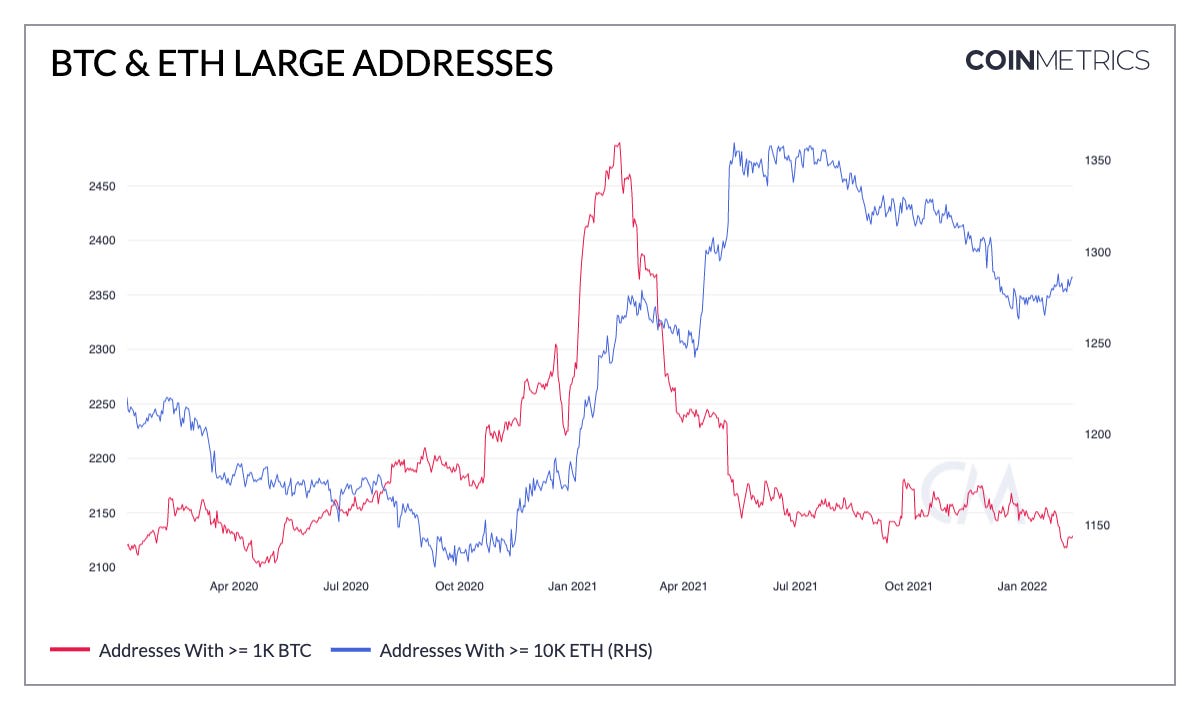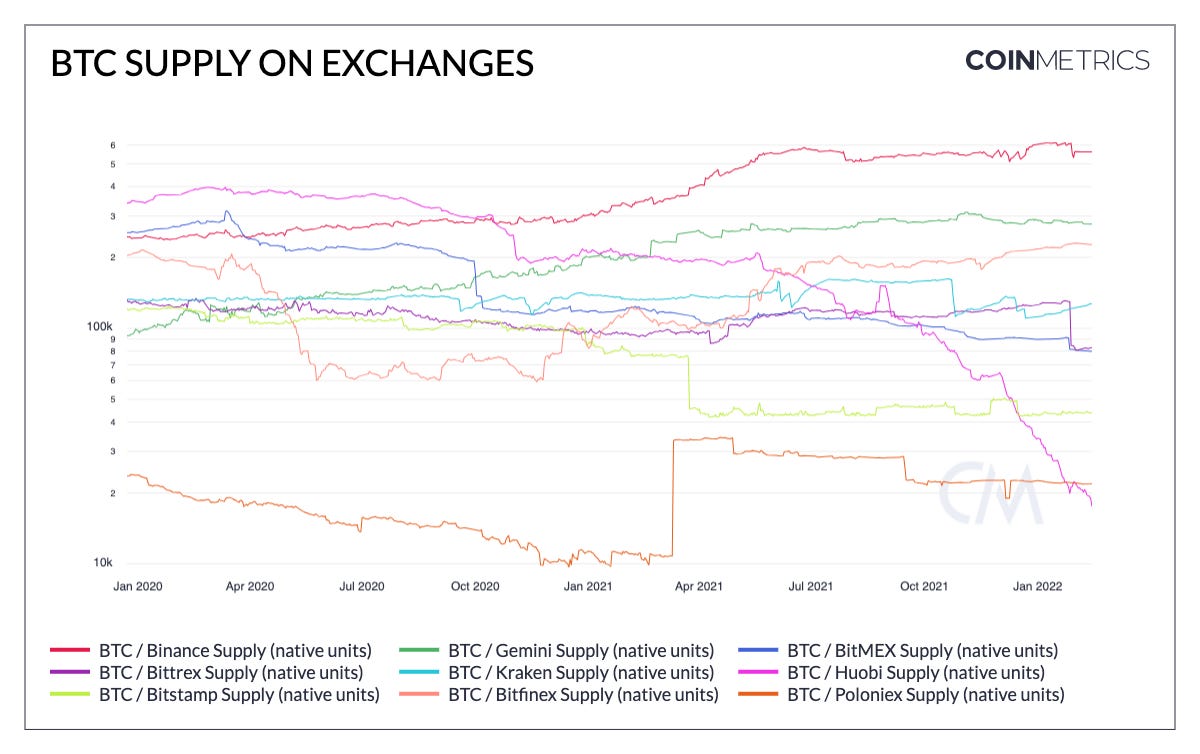Coin Metrics' State of the Network: Issue 142
Tuesday, February 15th, 2022
Get the best data-driven crypto insights and analysis every week:
Searching Millions of SEC Filings for Crypto-Related Terms
By Kyle Waters and Nate Maddrey
The first ever mention of Bitcoin in a document filed with the U.S. Securities and Exchange Commission (SEC) was appropriately entrepreneurial: “STARTING A BITCOIN VENTURE.” Found in a supplementary list of loan requests submitted by a peer-to-peer lending company Prosper Marketplace in June 2011, the filing details a California-based computer programmer’s plans to use a $7K loan to invest in bitcoin (BTC), build computers to mine bitcoin, and rent an office to establish a brick & mortar BTC/USD exchange.
Since then, Bitcoin has been mentioned in 11,510 SEC filings by 2,169 unique filing entities. Publicly-traded companies in the US and other institutions like investment funds have long been reporting financial results (e.g. quarterly and yearly updates in 10-Q and 10-K filings) and communicating guidance on future plans and other economic information via documents submitted to the SEC.
These filings are numbered in the millions and hold a wealth of data for researchers, economists, investors, and others. Just like the first ever filing to mention Bitcoin shows, SEC filings can be useful alternative data to analyze trends in investment interest and adoption of crypto assets.
As more institutions and crypto companies from exchanges to Bitcoin miners receive debt and equity funding from public markets, the amount of filings mentioning crypto are increasing. In this week’s SOTN, we mined filings in the SEC’s EDGAR database for crypto-related terms, searching for signs of institutional interest and more.
Initial Data Analysis
The SEC provides a “full-text search” tool that allows users to discover filings in EDGAR containing case-insensitive strings of text like “B(b)itcoin” during specific time ranges, for example, all filings mentioning “Bitcoin” in the last 30 days. This covers all file types from prospectuses to earnings announcements and company presentations, for example.
The chart below shows the number of filings by month mentioning Bitcoin plotted against BTC’s price.
The number of mentions closely tracks historical price cycles, and has risen during bull runs. Mentions of Bitcoin were fairly rare until 2017 when they accelerated during that year’s price rise. They were again pretty flat until BTC’s price started rising during 2020/21 when mentions increased dramatically.
A similar trend is noticeable for other crypto-related terms. Below are the number of filings mentioning “ethereum” and “blockchain” by month, which increased significantly in 2018 and going into 2021.
Entity-Level Data
The number of filings is a useful starting point, but is a fairly rough proxy. Once a company starts mentioning Bitcoin (such as a Bitcoin miner) they will likely continue mentioning it or mention it everywhere in each filing (e.g. in disclaimers, business description).
Another way to slice the data is by looking at the number of unique entities that are mentioning crypto-related terms. Entities include companies such as the Bitcoin mining company Riot Blockchain (RIOT) to asset-management companies such as Grayscale to companies with operations not primarily focused on crypto such as Tesla (TSLA) or Microstrategy (MSTR) that hold BTC on their balance sheets.
The number of unique entities mentioning crypto terms has increased since 2020, which reflects a broader trend of crypto’s growing institutionalization. Bitcoin miners have also accounted for much of the increase. There are now over 40 publicly-traded Bitcoin mining companies on US and Canadian exchanges.
Gauging Institutional Interest in 13F Filings
Deciphering institutional from retail interest is a particularly challenging problem in crypto research. One rough proxy is looking on-chain at the number of addresses holding relatively large amounts of native assets. Going into 2021, the number of addresses holding high balances of BTC and ETH rose, aligning with anecdotal evidence that institutional interest was picking up then. However, the trend seemingly broke during the second half of 2021 by this measure.
Source: Coin Metrics’ Formula Builder
Certain types of SEC filings can also be useful to measure institutional interest in crypto assets. Most investment funds that operate and conduct business in the US with at least $100M of assets under management (AUM) have to report a 13F filing that discloses each fund’s holdings to the public on a quarterly basis. Only a subset of a fund’s investments need to be reported however, and any positions in spot BTC do not need to be reported along with other spot commodities and currencies not treated as 13(f) securities. However, crypto-related investment vehicles such as trusts are often reported.
The chart below shows the number of 13F filings mentioning Bitcoin which increased going into the beginning of 2021 but dipped somewhat in Q2 and Q3 last year, aligning with the on-chain data.
To date, a popular way institutions have gained exposure to BTC has been through trusts, such as Grayscale’s Bitcoin Trust (GBTC), the largest by net asset value (NAV) that currently holds around 643K BTC valued at ~$27B. GBTC’s BTC holdings increased steadily along with the number of investment funds mentioning BTC in their 13F filings during 2020-2021.
While GBTC holdings have flatlined since early 2021, 13F filings mentioning Bitcoin accelerated at the end of 2021. This reflects the introduction of the first (futures based) exchange-traded BTC products in the US in October 2021 which included the launch of ProShares’ Bitcoin Strategy ETF (BITO) and Valkyrie’s Bitcoin Strategy ETF (BTF) that hold BTC futures contracts traded on the CME. These funds are now being reported on 13F filings, accounting partially for the increase in unique entities.
A similar trend from 2020 to 2021 is noticeable for Ethereum, reflecting its growing interest with institutions. However, there has yet to be any Ethereum ETF approved in the US, leaving trusts as the primary investment vehicle.
Conclusion
Looking at public SEC filings can be a helpful way to measure crypto’s growing presence in the US economy. Regular reporting is often viewed as an important component of the financial markets to assess performance and to analyze other disclosures. While it will be useful to keep watching for new information in future filings, it’s worth noting that public blockchains can enable far more granular updates. Crypto data is ushering in a new era of effectively real-time economic insights powered by on-chain data, a topic we have discussed before, and aim to expand on again in the future.
Network Data Insights
Summary Metrics
Source: Coin Metrics Network Data Pro
Activity on-chain on Bitcoin and Ethereum was mostly flat week-over-week with active addresses only rising about 3% on Bitcoin and 1% on Ethereum. In a potential sign of how much activity on Ethereum is currently US-focused, on-chain activity slowed on Superbowl Sunday with ETH fees averaging under $15 per transaction in a day for the first time since September 25, 2021.
Network Highlights
The percentage of BTC transactions involving exchanges has fallen to about 14% of daily transactions – about the same level as December 2020 – after peaking in the last year in May 2021 at around a quarter of all daily BTC transactions.
Source: Coin Metrics’ Formula Builder
Looking at all of the exchanges Coin Metrics tracks, Huobi now holds the smallest amount of BTC at 21K, after holding the most as recently as October 2020 when it held 300K BTC. This is further evidence of an ongoing global shift in crypto activity as Huobi has adjusted to new restrictions from the Chinese government.
Source: Coin Metrics’ Network Data Charts
Coin Metrics Updates
This week’s updates from the Coin Metrics team:
Check out our market-data focused newsletter State of the Market, featuring weekly updates on market conditions.
Coin Metrics is hiring across Research, Data Science, Growth and more! Check out our open positions here.
Also check out the Coin Metrics mobile app. View real-time cryptoasset pricing and relevant on-chain data in a single app! Download for free here: https://coinmetrics.io/mobile-app/
As always, if you have any feedback or requests please let us know here.
Subscribe and Past Issues
Coin Metrics’ State of the Network, is an unbiased, weekly view of the crypto market informed by our own network (on-chain) and market data.
If you'd like to get State of the Network in your inbox, please subscribe here. You can see previous issues of State of the Network here.
Check out the Coin Metrics Blog for more in depth research and analysis.
© 2022 Coin Metrics Inc. All rights reserved. Redistribution is not permitted without consent. This newsletter does not constitute investment advice and is for informational purposes only and you should not make an investment decision on the basis of this information. The newsletter is provided “as is” and Coin Metrics will not be liable for any loss or damage resulting from information obtained from the newsletter.













